MILO AND SANDOW — The Original Bodybuilders
- Julian Molteno
- Apr 6, 2019
- 6 min read
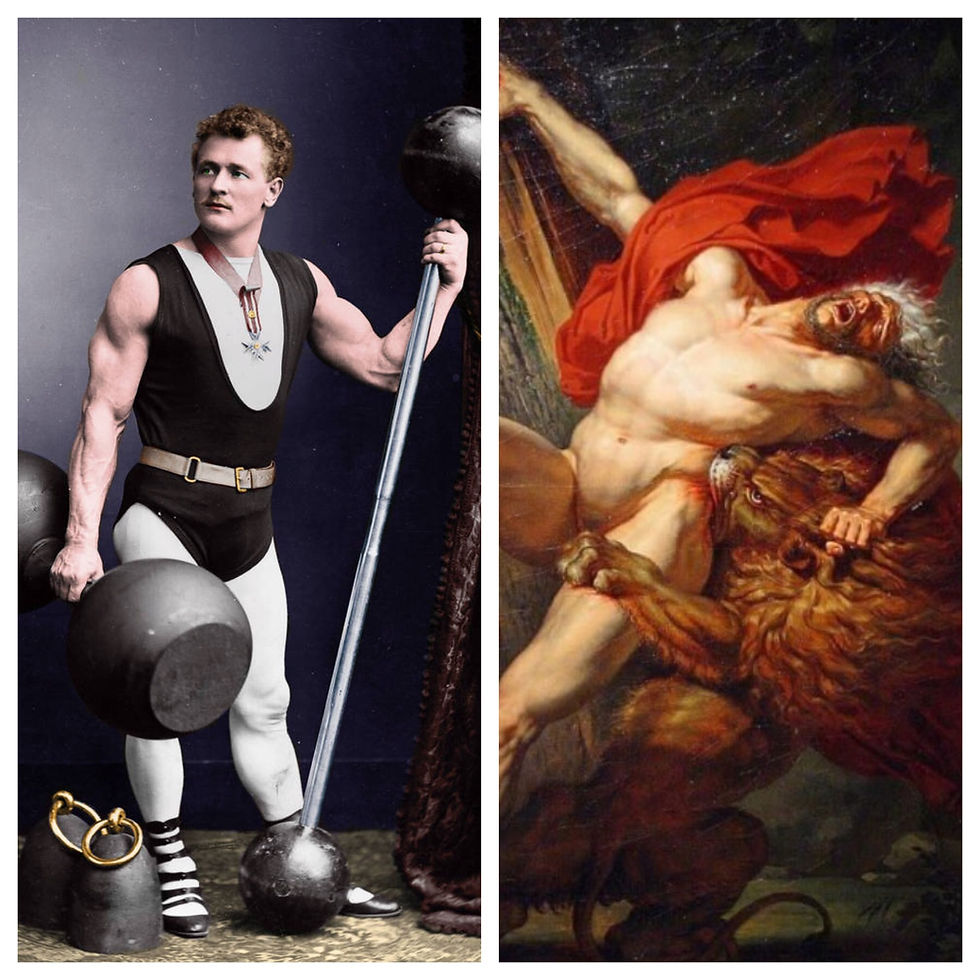
Bodybuilding, both ancient and modern, can trace its origins back to two men — separated by more than two and a half thousand years, but bound together by the joy of physical toil, the worship of strength, and by the glory that is the muscular male body.
Eugen Sandow was born in 1867 to a Jewish family in Prussia. By the time he was 19, he was already performing as a strongman in travelling shows, well known for his impressive barbell routines, and for breaking a chain locked around his chest. After leaving Prussia to avoid military service, and travelling throughout Europe as a circus athlete, Sandow travelled to London, at the age of 22, to take part in a strongman competition. Sandow handily beat the reigning champion and won instant fame and recognition for his strength, launching him on a career as an athletic superstar.

Eugen Sandow displays his impressive musculature. Sandow soon found, however, that his Victorian audience was more fascinated by his perfectly developed muscles than by the amount of weight he was lifting. He devised a routine where he would move in poses which he dubbed "muscle display performances" . . . and the legendary strongman added these displays in addition to performing his feats of strength with barbells. He was soon receiving requests to perform from all over Britain. By the end of his eventful and successful life, Sandow had achieved much. He opened the first of his Institutes of Physical Culture, where he taught methods of exercise, dietary habits and weight training. In 1898 he also founded a monthly periodical, titled Sandow's Magazine of Physical Culture that was dedicated to all aspects of muscular development and strength training. This was accompanied by a series of books published between 1897 and 1904 — the last of which contained the term “bodybuilding” in the title.

I’m 1901, Sandow organized the world’s first major bodybuilding competition in London's Royal Albert Hall. The venue was so full that people were turned away at the door. The three judges presiding over the contest were Sir Charles Lawes the sculptor, Sir Arthur Conan Doyle the author, and Sandow himself.
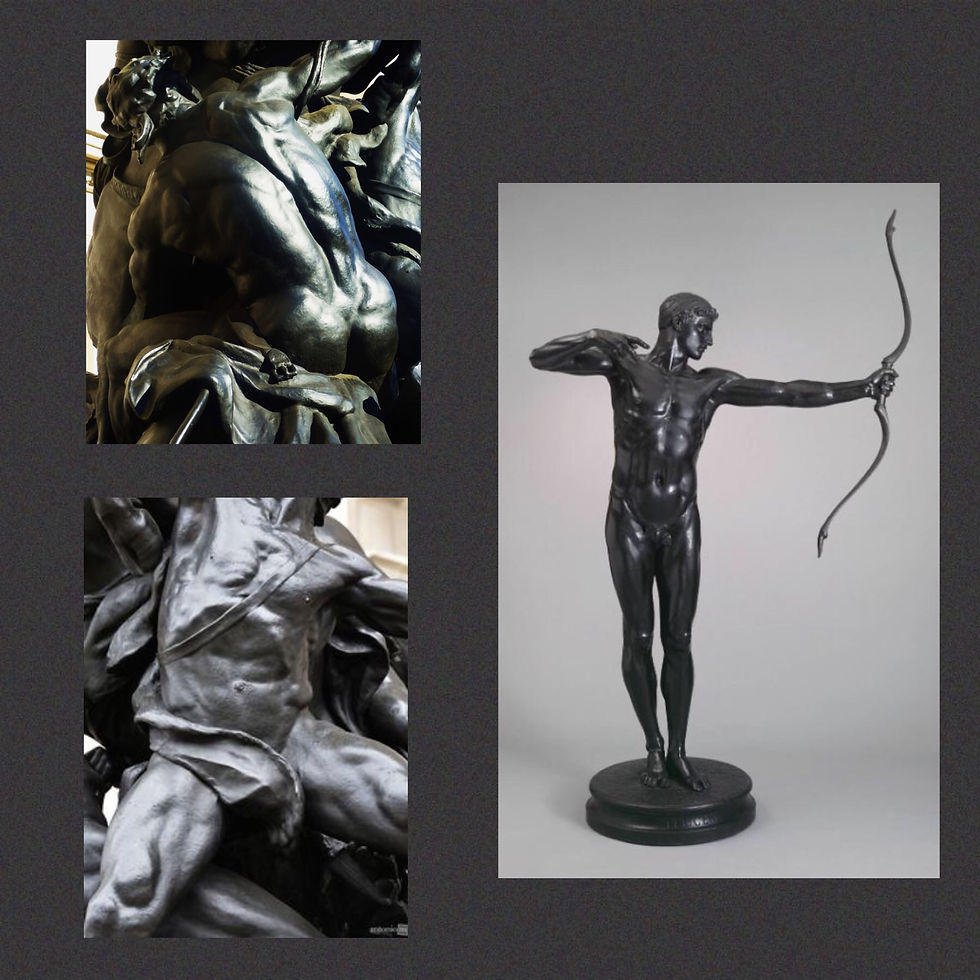
Who better to judge this new “bodybuilding” contest than the creator of these sculptures, Sir Charles Lawes. Sandow travelled around the world with his bodybuilding and strength shows, and in 1921, was even designated special instructor in physical culture to King George V, who followed his teachings.
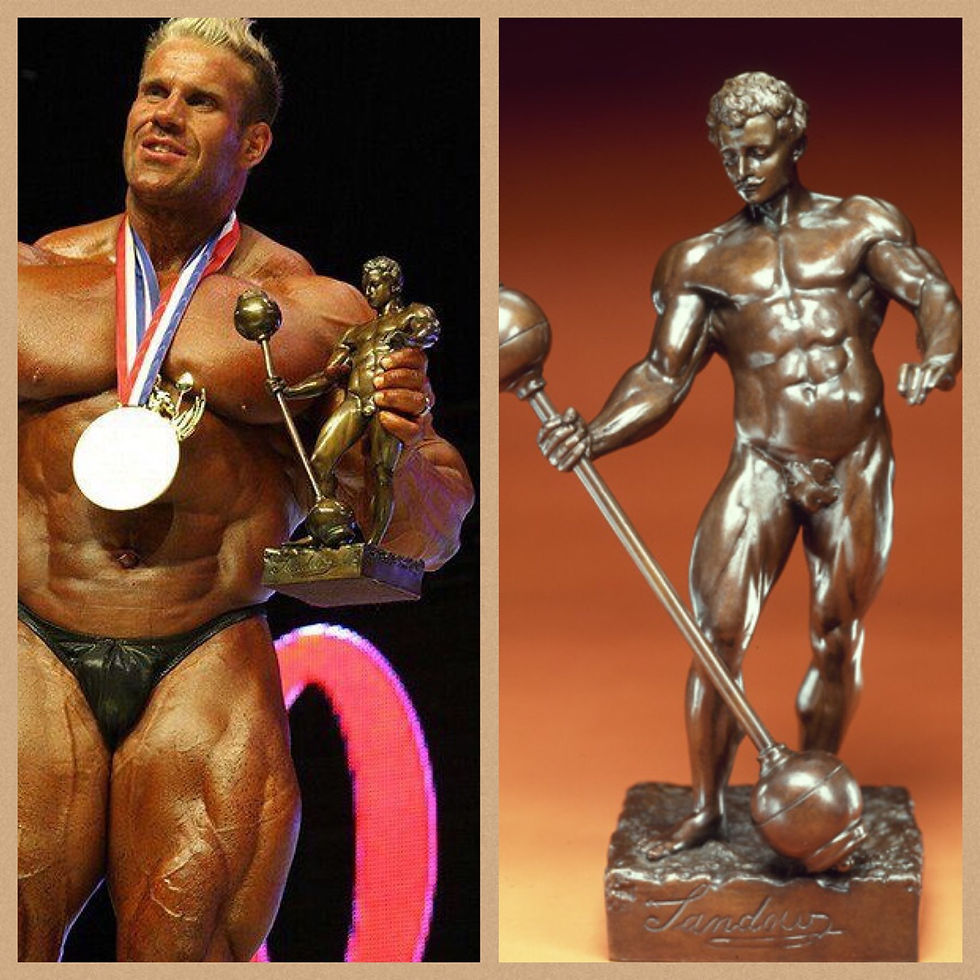
The statuette (of himself) that Sandow commissioned for the winner of his bodybuilding show, is presented even now to winners of the Mr Olympia contest. Sandow's resemblance to the physiques found on classical Greek and Roman sculpture was no accident. He measured the statues in museums and helped to develop "The Grecian Ideal" as a formula for the "perfect physique”. Sandow built his physique to the exact proportions of his Grecian Ideal, and as one of the first athletes to intentionally develop his musculature to predetermined dimensions, he is now acknowledged as the father of modern bodybuilding.
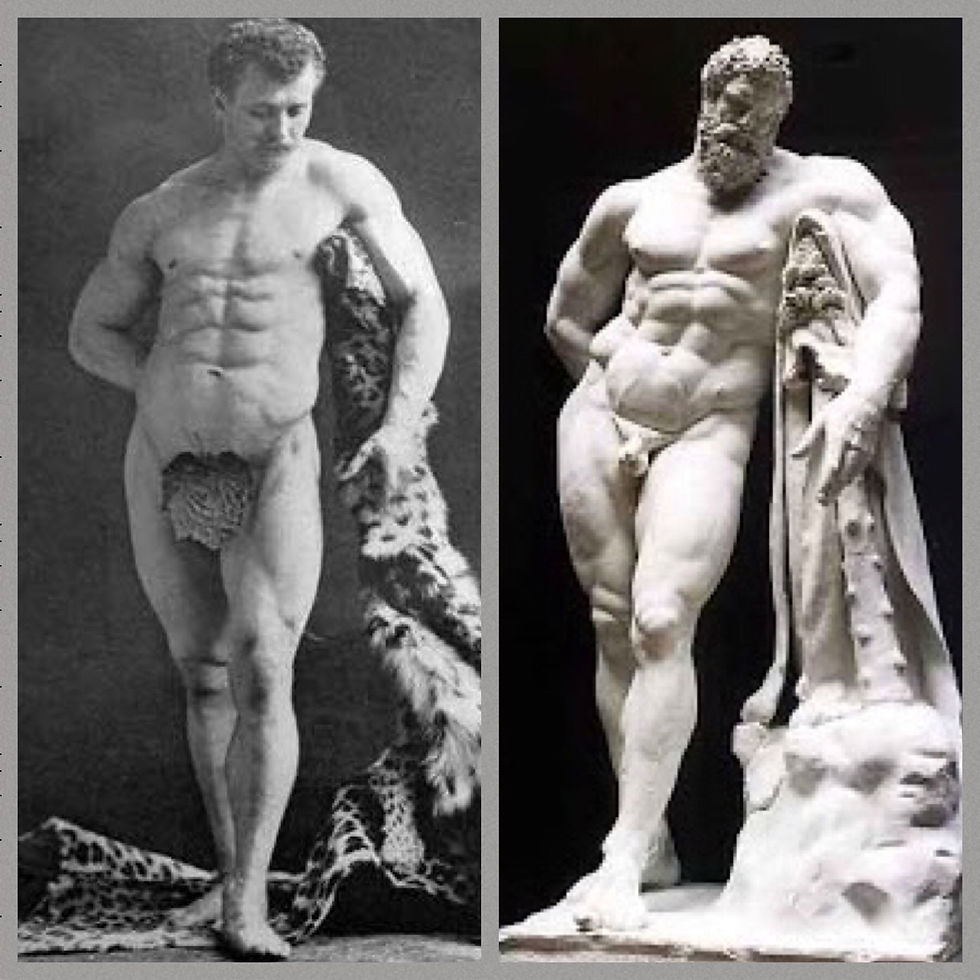
Sandow’s tribute to the famous statue of Hercules. If Sandow modelled his physique on, and drew his inspiration from, the Ancient Greeks, we need to take a closer look at just who these muscular marvels were, and more specifically, who the greatest of them all was — Milo of Croton!

Milo of Croyon, wearing a hero’s wreath, a lion skin and carrying a club. Milo was a 6th-century BC wrestler from the city of Croton, who enjoyed a brilliant wrestling career and won many victories in the most important athletic festivals of ancient Greece. Milo was a six-time Olympic victor. He also won seven crowns at the Pythian Games at Delphi (one as a boy), ten at the Isthmian Games, and nine at the Nemean Games. Milo was a five-time Periodonikēs, a "grand slam" sort of title bestowed on the winner of all four festivals in the same cycle. The reverential awe in which athletes were held in Greece led to exaggeration in the tales surrounding their lives. In Milo's case, Aristotle began the myth-making process with reports comparing Milo to Hercules in his enormous appetite, and feats of strength. One report says the wrestler was able to hold a pomegranate, without damaging it, while challengers tried to pry his fingers from it, and another report says he could burst a band fastened around his brow by inhaling air and causing the temple veins to swell. His daily diet allegedly consisted of 9 kg of meat, 9 kg of bread, and 10 litres of wine. Milo's invincibility in competition was also attributed to the wrestler's consumption of alectoriae, the gizzard stones of roosters. When a bird swallows small bits of gravel that act as 'teeth' in the gizzard, breaking down hard food such as seeds and thus helping digestion, these stones are called gizzard stones or gastroliths and usually become round and smooth from the polishing action in the animal's stomach.
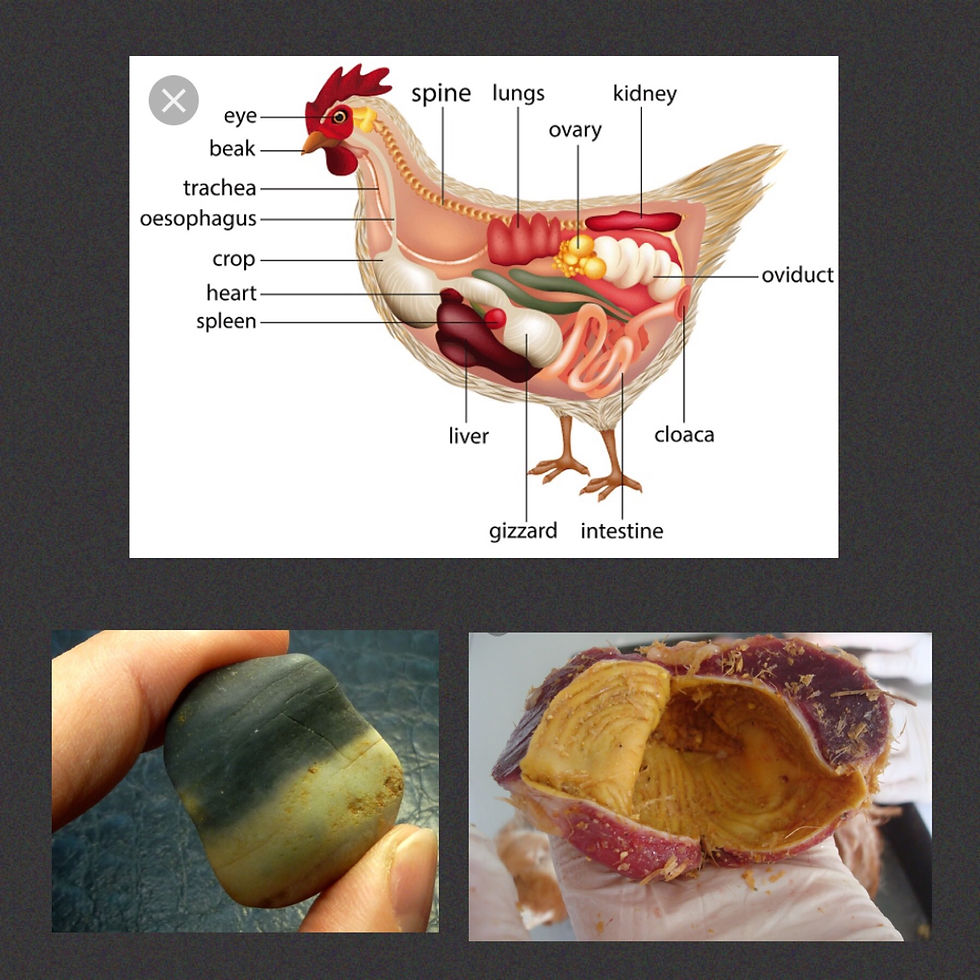
A capon stone is a non-precious stone found in the gizzard of capons (young, castrated roosters). In magic it is believed to be an effective amulet, granting the wearer a heightened sense of courage and boldness. There is one particular story about Milo that we, as bodybuilders, are very interested in. Legend has it that one day Milo picked up a new-born calf, slung it over his shoulders, and walked the perimeter of his farm. Milo performed this task every day for four years, and as the calf grew bigger and heavier, Milo grew bigger and stronger. And thus, without realising it, Milo had discovered the cornerstone of developing muscle size and strength — The Progressive Overload System!

What did Milo do with the bull at the end of the four years? Slaughtered, roasted, and devoured it — all in a single day! After Milo accidentally stumbled on the key to developing muscle mass and strength, his discovery lay virtually unused for a few thousand years. Known only vaguely, and utilised in a haphazard manner by a few strongmen, it took a US Army surgeon and the Second World War to bring this amazing technique to the attention of medical science — to give it structure and order, and to then spread the word to the wider athletic and sports community. (But that is another story, a story that starts with the virtually unknown Thomas L. DeLorme and ends with two of bodybuilding’s most charismatic men — Joe Weider and Arnold Schwarzenegger.) And what of our two heroes, these two men both possessed of extraordinary physical gifts, and both feted by their respective generations? Interestingly, not only were they connected by the type of lives they lived, they were connected by their deaths too. Sandow died at his home in Kensington, London, in 1925 of what newspapers announced as a brain haemorrhage at age 58. It was allegedly brought on after straining himself, without assistance, to lift his car out of a ditch after a road accident two or three years earlier. Milo too met with a somewhat inglorious end. The date of Milo’s death is unknown, but according to tradition, Milo met his fate while making his way through a thick wood. He strayed considerably out of the path, and when finding a great log with wedges in it, the ageing Milo thrust both his hands and feet into the fissure, intending to split it completely. He was only able to force it open enough to let the wedges fall out, and when the gaping log presently closed on him, he was then trapped and devoured by wild beasts.

The Death of Milo of Croton by Jean Jacques Bachelier.
I like to think that though Sandow and Milo were of different times, different cultures, and different nationalities, if the almighty Zeus were to have arranged their meeting on the summit of Mount Olympus, these two strangers, standing atop that sacred mountain, would have looked at one another and instantly recognised in themselves, kindred spirits, bound together by their strength, their musculature, their physical prowess, and their life-long love of energetic physical endeavour. I love this photograph, taken of an older Eugen Sandow. I like his mischievous expression and the twinkle in his eye. It confirms my suspicion that men and women who have a love for physical pursuits, often have a great appetite for life and a wonderful bonhomie!
